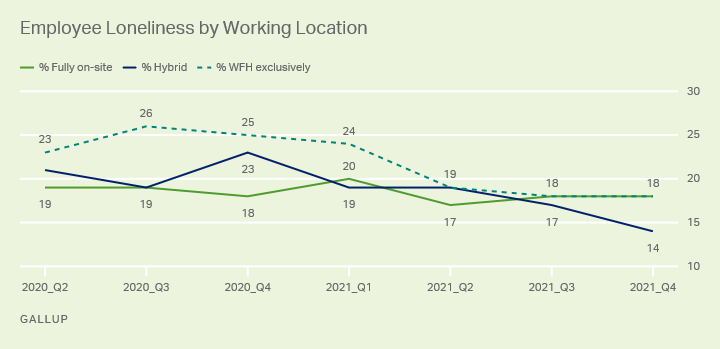As millions of people shifted to working from home in 2020 and early 2021, those who worked remotely 100% of the time reported higher percentages of "loneliness a lot of the day yesterday."
The picture brightened around the second quarter of this year -- as vaccines became more available and people began to socialize more freely -- and loneliness for fully remote workers dropped to levels indistinguishable from hybrid and fully on-site workers.
Why is that? One possibility is that remote workers adjusted and acclimated as they became more accustomed to working from home. Or that the surplus of lonely remote employees in 2020 were among the first to return once offices started to open up.

A line graph showing self-reported feelings of loneliness "a lot of the day yesterday" among employees who work remotely, on-site, or some combination of the two. In Q2 of 2020, those who worked from home exclusively reported higher loneliness at 23% through the start of 2021 compared with hybrid workers at 21% and on-site workers at 19%. In early 2021, this evened out and those who work from home and those who are on-site report similar loneliness at 18%, whereas hybrid workers report just 14%.
Yet even as those employees feel less lonely and isolated, it's still critical that organizations nurture and foster social wellbeing in their workforces -- and keep an eye out for employee loneliness.
Gallup's research has found that social wellbeing is one of the foundational elements of a thriving overall life -- social time is an essential element of human nature and an important part of an engaging workplace. Research published in PNAS in 2010 by Nobel Prize winners Daniel Kahneman and Angus Deaton found, for example, that being alone was one of the top correlates with not experiencing positive emotions such as enjoyment and happiness -- and correlated with a high incidence of negative emotions such as stress, worry and sadness.
There are clear business benefits to reducing loneliness. Gallup has found that having friendships at work is a predictor of many important business outcomes, including customer service and profit.
The great shift to remote work in 2020 created increased social vulnerability for many who worked from home. And even though things improved for people who worked remotely in Q2 of 2021, almost two in 10 workers, regardless of where they do their work, still report feeling lonely.
Management practices that can reduce loneliness:
Identify each person's strengths and make strengths integral to your management practice and culture. Loneliness is less likely when employees are aware of their strengths and able to share them with and leverage one another's strengths. Employees can get to know one another more quickly if they have a common language to describe one another's natural tendencies. Also, doing productive work with others builds social bonds. Fifteen percent of those who strongly agree that they have an opportunity to do what they do best report "feeling lonely. This compares with 40% who strongly disagree and 32% who disagree.
Cultivate respect among coworkers. Work environments with high equity and accountability can serve to reduce loneliness because coworkers are more likely to respect one another's work. Gallup's research found that 16% of employees who strongly agree that their coworkers are committed to quality work reported feeling lonely compared with 40% of those who strongly disagreed and 28% of those who disagreed.
Encourage friendships at work. Leaders and managers should embrace the social component of work and initiate situations for employees to get to know one another personally. Why? Because people don't leave their human nature behind when they're on the job. Assuming that team members have clear roles, are adequately recognized and are given chances to develop, workplace friendships can bring cooperation, innovation, inclusion, and belonging.
Low social wellbeing and loneliness can have major effects on both employee performance and employees themselves:
- Set your employees on the right path to higher wellbeing, learn more about our wellbeing approach as the key to workplace productivity.